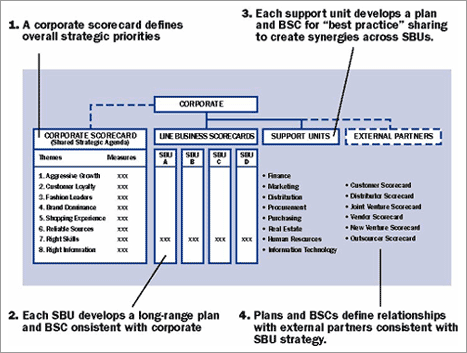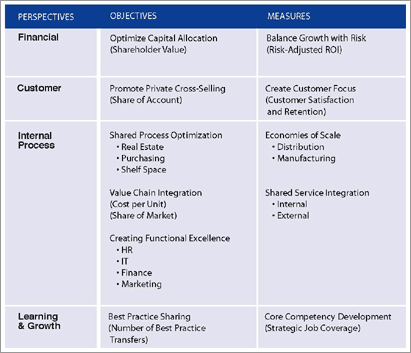|
The Corporate Scorecard: Making the Whole Greater Than the Sum of Its Parts |
|
By David P. Norton |
![]() How
does a corporate organization create value? By ensuring that synergy is achieved
across business units. But to align and link the organizations, you need a
framework.
How
does a corporate organization create value? By ensuring that synergy is achieved
across business units. But to align and link the organizations, you need a
framework.
The Balanced Scorecard provides a powerful framework for individual business units to describe and implement their strategies. A strategy-focused organization, however, requires more than each business unit managing with its own Balanced Scorecard. The reason? Most organizations consist of many different business units as well as shared service or support units. For maximum effectiveness, the strategies and the scorecards of every unit should be aligned and linked together. The linkages across the scorecards put into action the theory of managing decentralized businesses and shared service units within a single corporate umbrella. These linkages make up the strategic architecture of the organization; that is, the way in which the organization will create value-adding synergies by integrating the activities of otherwise segregated units.
The starting point in rationalizing this strategic architecture is to create a clear definition of the corporate role. The purpose of the corporate (or group or sector) entity is to create synergies among the business and support units. Without synergies, there is no corporate role — and the question could be raised as to whether the lower-level units might be more profitably spun off.
The corporate role can be translated into a set of priorities, and a scorecard by which the priorities can be communicated to other parts of the organization. Figure 1 illustrates the corporate scorecard of a fashion retailer that was used as a template to define the priorities shared by each business and support unit.

Corporate strategy, captured in the scorecard, creates synergies among the strategic business units (SBUs) in several ways. It establishes growth targets across the portfolio of businesses that would create attractive shareholder value. It clarifies the marketing goals — fashion leadership and brand dominance — required to project a consistent corporate image. It defines the opportunity to create economies of scale in both real estate and purchasing sourcing. Finally, it defines the opportunity to share intellectual capital in the form of key personnel and information systems. While each SBU develops its own strategy and its own scorecard, each is guided by the corporate template. The synergies defined in the corporate scorecard create an organization in which the whole is truly greater than the sum of its parts.
The Role of the Corporation
The corporate strategic architecture is quite different from that of an SBU. The strategy map approach (see BSR November – December 1999) describes the strategic architecture of an SBU. This architecture tends to be organized around homogeneous groups of customers, products, processes, and competencies. The corporation, however, is a collection of SBUs. Each industry and each strategy creates a different set of demands for business-unit integration and, hence, a different corporate role. For example, a financial conglomerate like FMC Corporation has few synergies across its business units. The SBUs share only the capital base of the corporation; hence, the corporate role is primarily a financial one, creating synergy through the efficient use of capital. Its corporate scorecard would stress cash flow, working capital efficiency, return on capital, and similar measures that monitor the productivity of capital investments.
Organizations like Citicorp or Chase Manhattan Corporation face different challenges. Their strategies involve providing a broad set of financial services such as credit cards, mortgages, personal loans, and checking services to the same customers. Each of these services is delivered by a different SBU that has historically been independent, but in this case the SBUs share the customer base of the organization. The role of the corporation is to create synergy through the sharing of customers across SBUs. The corporate scorecard would emphasize share of wallet, cross-selling, or integrated products.
Many organizations share business processes and require a corporate entity to ensure their most effective use. The Limited, a fashion retailer, has a family of brands that includes Victoria’s Secret, Express, and Abercrombie & Fitch, all of which are targeted at different customers but located in the same major shopping malls in America. The corporate organization needs to develop a real-estate strategy that meets the combined needs of all business units. The corporate scorecard would include measures such as a comparison of “blended sales per square foot” to selected benchmarks. Food-brand companies like Pillsbury and Nabisco have similar corporate roles built around sharing distribution channels and retail shelf space across their many brands.
Brown & Root Energy Services
Brown & Root Energy Services (BRES) used the Balanced Scorecard to implement a strategy of value-chain integration. A division of the Halliburton Company, BRES consisted of six independent companies, each supplying a different service for marine construction: engineering, purchasing, fabrication, installation, operations, and logistics and service. While most of the operating companies had many customers in common, neither the customers nor the BRES companies had attempted to benefit from these shared relationships.
BRES President Norm Chambers and his executive team observed inefficiencies, duplications, and confusion at the interfaces of their companies. They believed that by combining efforts, BRES could provide a unified and integrated service. In its most complete form, BRES could design a structure (such as a drilling rig), produce the critical parts for it, install them, and operate and service the structure. In effect, they could provide a cradle-to-grave service for the customer. If all of the businesses were of this turnkey type, the rationale for having six independent companies would be weak. In effect, the new strategy would transform BRES from being a low-cost supplier to being the supplier that could best lower its customers’ costs. Because front-end investments required to bring a new undersea field into production range anywhere from $1 billion to $2 billion, savings to the customer from a lower-cost, integrated strategy could be substantial.
The BRES corporate role (in this case example, it was actually a divisional role) for more integrated strategies at the operating company level was expressed in their scorecard (see Figure 2). The financial perspective for this strategy identified a new objective: increase revenue from services that involve multiple operating companies. This perspective communicated an objective to obtain new business by providing integrated and turnkey services to customers. The two objectives in the customer perspective were:
to build strong relationships with targeted customers who would be willing to allow BRES to take on a broader scope of work, and
to lower the life-cycle costs for customers who contracted with BRES to offer integrated services across the value chain.

The second objective was measured by the reduction in life-cycle cost per barrel at the well-head. The life-cycle cost per barrel was compared with the cost achievable by independent companies that could not collaborate. This outcome measure reflected how much the total cost curve could be lowered through integrated operations. BRES wanted to shift its business model away from providing inputs (engineering and fabrication man-hours) to customers toward achieving outputs (lower costs) for its customer by providing complete solutions. Objectives and measures could then be defined for the learning and growth perspective and the internal perspective. In turn, these definitions would enable the financial and customer objectives to be achieved.
Each of the BRES SBUs could then include objectives that would reflect their contribution to achieving the division-level strategic theme of integrated operations. The individual company scorecards signaled the importance of gaining new capabilities for integrated service delivery and measured progress in winning new business and delivering cost-effective services in concert with other BRES companies.
In its first year of operating with the new integrated service strategy, BRES increased its revenues by 33%. The total percentage of revenues from integrated contracts rose from 11% to 30%. In one example of an early success of the new strategy, British Petroleum (BP) chose BRES to manage an integrated team of seven different companies (four Brown & Root companies and three independent companies) to bring the new Andrew Development field in the North Sea onstream. Using the Balanced Scorecard as an integrating framework to align the objectives of all the alliance companies, Brown & Root successfully completed the new field development six months in advance of the original 25-month schedule and $150 million under budget. For example, by working together to develop creative solutions, the hook-up of a new well in the Andrew field, a process that normally took an average of 90 days at a cost of $250,000 per day, was done in 1.5 days. The total savings on the project were shared between BP and the alliance companies, with several of the companies receiving performance awards totaling 20% of their previous year’s annual income.
Summary
Figure 3 summarizes the spectrum of value-added corporate roles that we have observed while developing Balanced Scorecard programs. The construction of a corporate scorecard using this framework can provide simple but powerful insights. The basic question corporations face is, “How can the corporate organization create synergies across business units?” The Balanced Scorecard framework helps answer this question by focusing attention on synergies from the four assets that create strategic success: capital, customers, processes, and knowledge. By defining these synergies in a corporate scorecard and then linking them to SBU scorecards, companies can create an alignment that will amplify the value of these assets. The Balanced Scorecard provides a concrete tool to deliver the Holy Grail of corporate management: making the whole greater than the sum of the parts.
